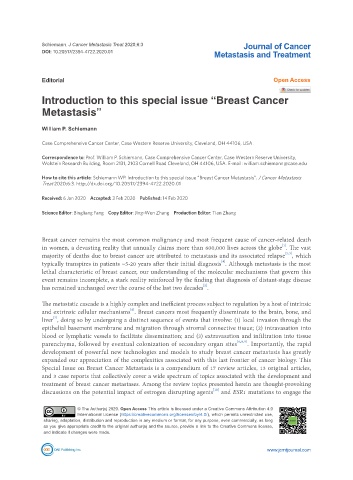Page 401 - Read Online
P. 401
Schiemann. J Cancer Metastasis Treat 2020;6:3 Journal of Cancer
DOI: 10.20517/2394-4722.2020.01 Metastasis and Treatment
Editorial Open Access
Introduction to this special issue “Breast Cancer
Metastasis”
William P. Schiemann
Case Comprehensive Cancer Center, Case Western Reserve University, Cleveland, OH 44106, USA.
Correspondence to: Prof. William P. Schiemann, Case Comprehensive Cancer Center, Case Western Reserve University,
Wolstein Research Building, Room 2131, 2103 Cornell Road Cleveland, OH 44106, USA. E-mail: william.schiemann@case.edu
How to cite this article: Schiemann WP. Introduction to this special issue “Breast Cancer Metastasis”. J Cancer Metastasis
Treat 2020;6:3. http://dx.doi.org/10.20517/2394-4722.2020.01
Received: 6 Jan 2020 Accepted: 3 Feb 2020 Published: 14 Feb 2020
Science Editor: Bingliang Fang Copy Editor: Jing-Wen Zhang Production Editor: Tian Zhang
Breast cancer remains the most common malignancy and most frequent cause of cancer-related death
[1]
in women, a devasting reality that annually claims more than 600,000 lives across the globe . The vast
[2,3]
majority of deaths due to breast cancer are attributed to metastasis and its associated relapse , which
[4]
typically transpires in patients ~5-20 years after their initial diagnosis . Although metastasis is the most
lethal characteristic of breast cancer, our understanding of the molecular mechanisms that govern this
event remains incomplete, a stark reality reinforced by the finding that diagnosis of distant-stage disease
[5]
has remained unchanged over the course of the last two decades .
The metastatic cascade is a highly complex and inefficient process subject to regulation by a host of intrinsic
[6]
and extrinsic cellular mechanisms . Breast cancers most frequently disseminate to the brain, bone, and
[7]
liver , doing so by undergoing a distinct sequence of events that involve: (1) local invasion through the
epithelial basement membrane and migration through stromal connective tissue; (2) intravasation into
blood or lymphatic vessels to facilitate dissemination; and (3) extravasation and infiltration into tissue
parenchyma, followed by eventual colonization of secondary organ sites [6,8,9] . Importantly, the rapid
development of powerful new technologies and models to study breast cancer metastasis has greatly
expanded our appreciation of the complexities associated with this last frontier of cancer biology. This
Special Issue on Breast Cancer Metastasis is a compendium of 17 review articles, 13 original articles,
and 3 case reports that collectively cover a wide spectrum of topics associated with the development and
treatment of breast cancer metastases. Among the review topics presented herein are thought-provoking
[10]
discussions on the potential impact of estrogen disrupting agents and ESR1 mutations to engage the
© The Author(s) 2020. Open Access This article is licensed under a Creative Commons Attribution 4.0
International License (https://creativecommons.org/licenses/by/4.0/), which permits unrestricted use,
sharing, adaptation, distribution and reproduction in any medium or format, for any purpose, even commercially, as long
as you give appropriate credit to the original author(s) and the source, provide a link to the Creative Commons license,
and indicate if changes were made.
www.jcmtjournal.com

